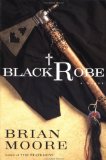Dream Power
By Peter LloydCreative problem solving requires at least one rule. It may be the one and only problem-solving rule we need to invent and innovate successfully. It's this: everyone involved must attack the problem while standing, if only temporarily, on common ground.
 I recently finished Black Robe by Brian Moore. At several points in the story, two central characters, a Jesuit priest and an Algonkin chief, struggled to make problem-solving decisions crucial to their survival. They failed to agree, because each approached the problem at hand hopelessly mired in his own mythical system.
I recently finished Black Robe by Brian Moore. At several points in the story, two central characters, a Jesuit priest and an Algonkin chief, struggled to make problem-solving decisions crucial to their survival. They failed to agree, because each approached the problem at hand hopelessly mired in his own mythical system. Their competing approaches drove them apart as they plied the Ottawa River. The priest wanted to baptize everything on two legs in order to assure its salvation. The Algonkin people read this behavior as sorcery, especially when events turned ugly. The chief guided his tribe by the revelations gleaned from his dreams. The priest and his partner read this as savage ignorance. Stalemate.
Then, even more recently, I read in ScienceDaily that the Algonkin approach may have more validity today in the minds of our general population.
According to "When Dreaming Is Believing: Dreams Affect People's Judgment, Behavior," six separate studies, involving almost a thousand people, reveal that people from all over the world believe that their dreams provide important hidden truths and meaningful insight into themselves and their world.
In one study an overwhelming majority of students from the United States, India, and South Korea, "endorsed the theory that dreams reveal hidden truths about themselves and the world."
Commuters in a Boston train station were asked, which of the four following signs would affect their decision to board an airplanes:
- The national threat level was raised to orange
- They consciously thought about their plane crashing
- They dreamed about a plane crash
- A real plane crash occurred on the route they planned to take
The dream had greater influence than thinking of a crash or a government alert and about the same impact as an actual crash.
But here's the crux of the matter. One of the studies uncovered confirmation bias. Namely, subjects tended to give more credence to dreams that supported their convictions.
While we know that our marvelous minds have more to offer us than we will ever have a chance to appreciate, the nitty-gritty of problem solving demands that we leave at the door of any problem-solving event any baggage that could stall the process. We must meet our problems on common ground and coordinate our attack with common purpose.
We can go back to separate prejudices and belief systems after we've found solutions we can all live with. If, in the meantime, common-ground problem solving has achieved what we both were after, everybody wins.
Peter Lloyd is co-creator with Stephen Grossman of Animal Crackers, the breakthrough problem-solving tool designed to crack your toughest problems.
